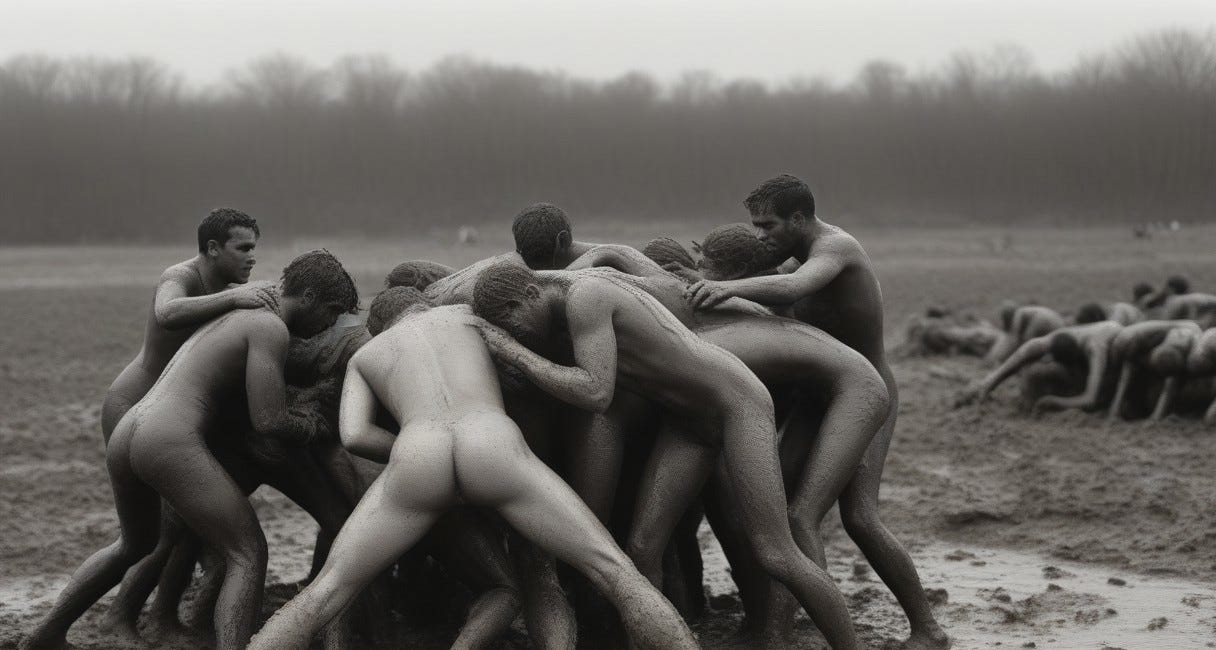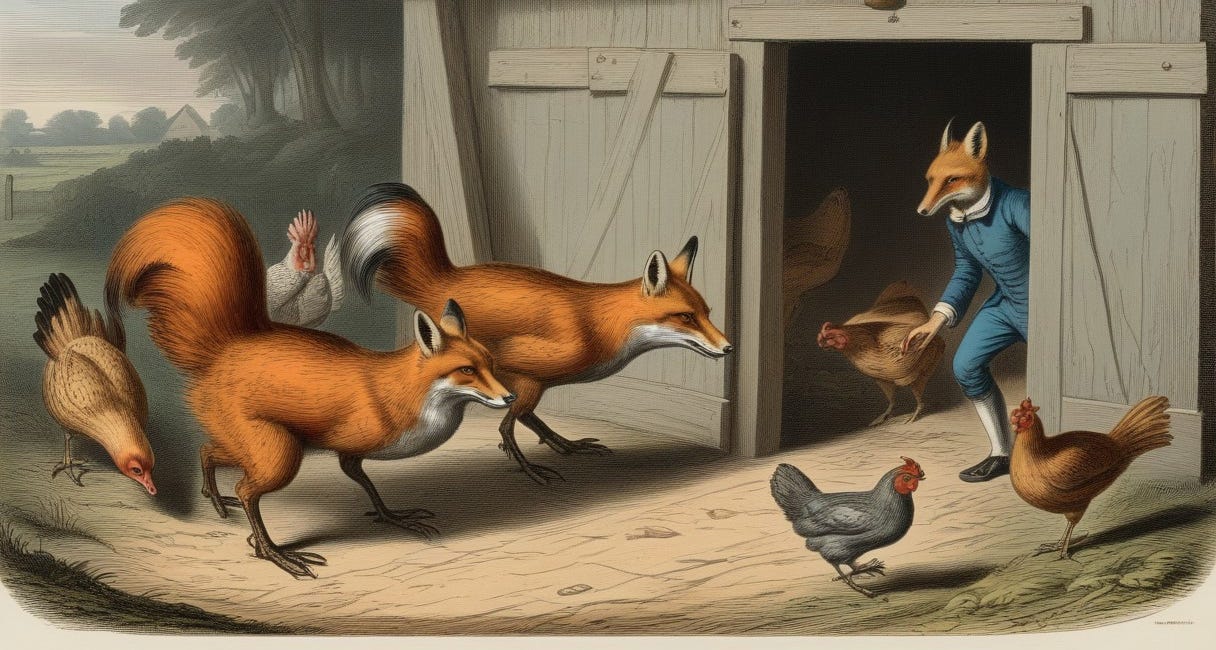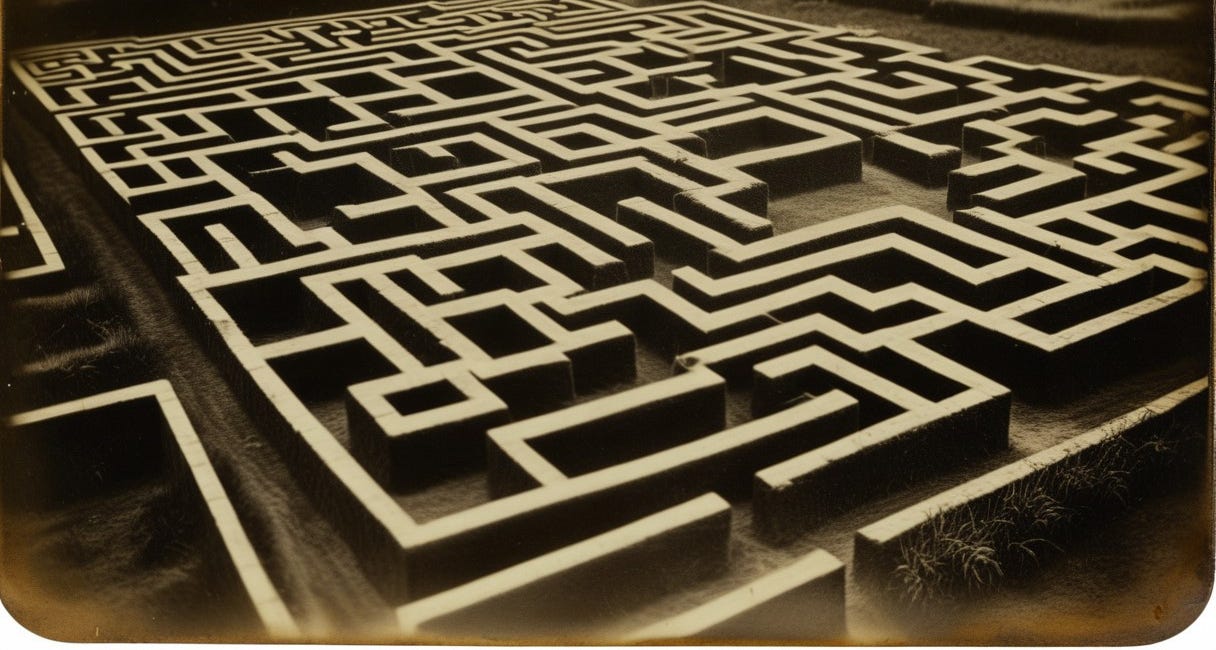mimesexuality 3: scutum mimesis
against male-male aggression and violence
scutum mimesis
To appear as female is to invoke a different set of rules (of perception; of protection; of prohibition). The body of the mimic is male—fully, unambiguously. Muscle, bone density, testosterone. But appearance is a currency of its own. The mimic does not need to be female; he only needs to be read as such. And in this reading, he inherits one of the strongest biological and cultural taboos: the prohibition against violence toward women.
This is not a minor distinction. Across species, across history, across war and law and daily life, the numbers hold: men die violently at twice the rate of women. Not accident, not illness—violence. The very condition of being male places the body within the arena of aggression. To be male is to be seen as fair game for attack. But to be female—or to be perceived as such—rewrites the equation. The dominant male will attack his rivals, his threats, his competitors. But he does not attack the feminine. His instinct forbids it. His social training forbids it. His culture forbids it.
Mimesexuals insist on the opposite (that they are the targets; that their existence is perilous; that to be read as female is to invite destruction). The opposite is true. Their survival rate is higher. Their exposure to direct male aggression is lower. They claim to inhabit the most vulnerable position, yet their very presence is a strategy of evasion—of sidestepping the lethal risks that define male existence. The dominant male sees a competitor and attacks; he sees the mimic, and hesitates. That hesitation is the mimic’s shield. That shield is what allows him to live.
violence taboo
Violence has rules. Not moral rules (though they are framed that way) but instinctive ones, evolutionary ones, social ones. Across species, dominant males fight each other for access—territory, mates, standing. The price of losing is exclusion, injury, death. The price of winning is constant exposure to the next challenge. It is a cycle, a structure that repeats itself. But within this structure, a prohibition emerges: males attack males, but males do not attack females.
Why? Not out of kindness. Not out of morality. Out of necessity. The reproductive economy is ruthless—females are the limiting resource, the bottleneck through which survival must pass. A system in which males routinely attacked and killed females would be an evolutionary dead end. And so, selection pressures enforce restraint. A dominant male may control, possess, even harm a female, but he does not annihilate her. If he does, he destroys his own reproductive future. Violence is structured, not chaotic. The body knows this before the mind does.
Mimesexuality exploits this structure. The mimic does not need to be female; he only needs to borrow the aura of female protection. His body, male in every way, is misread. He is not perceived as a rival, so he is not targeted. He is not read as a challenge, so the mechanisms of aggression do not activate against him. His survival rate rises—not because he is more fragile, more endangered, more at risk, but because he has escaped the condition of being perceived as male. The taboo that protects the female body, in that moment, extends to him.
body as misdirection
Mimesexuality is not about weakness. It is not about submission. It is about redirection. The mimic does not beg for protection; he does not ask for exception. He simply allows the system to misread him, and in doing so, steps out of the line of fire. He is male—every cell in his body, every genetic marker, every physiological structure. But his appearance, his manner, the way he moves through space—these things shape how he is treated. And treatment, not essence, is what determines survival.
The numbers are undeniable. Men suffer more violent deaths than women—not slightly, but exponentially. Twice as likely to be murdered. Far more likely to die in war. More likely to be killed in the street, in prison, in a fight, in an execution. Women are controlled, yes. Subjugated, limited, constrained. But they are not disposed of in the same way. Their bodies, as reproductive vessels, are too valuable to be casually destroyed. The mimic does not become female, but he absorbs this protection. He steps away from the category that is marked for violence and into the one that is spared.
And yet, mimesexuals insist on their own vulnerability (the most endangered; the most at risk; the most hunted). But what is claimed and what is true are not always the same. Their survival rates are higher. Their exposure to direct violence is lower. The instinct that spares the female body spares them, too. They insist they are attacked—but only by exception. They insist they are unsafe—but their numbers say otherwise. Their very success as a reproductive strategy is proof of their safety. The dominant male may dismiss them, may mock them, may even loathe them—but he does not kill them. And in a world built on male violence, that is the most decisive advantage of all.
illusion of precarity
Survival is not about strength (not always; not entirely). It is about placement. About being where the knife does not land, where the blow does not fall. The mimic’s power is not in resistance, but in redirection—he does not block the fist; he is simply not standing where it strikes. (Sun Tzu: the greatest victory is the battle not fought. Foucault: power is not only what oppresses but what moves unseen.) The dominant male is the target, the rival, the obvious site of aggression. The mimic is not. And in not being, he survives.
To be read as female is to step sideways, into a different architecture of violence. Not its absence (violence touches every category; no one is exempt) but its reconfiguration. Women are controlled, not discarded. Disciplined, not eliminated. Their suffering, real as it is, follows different patterns—coercion over confrontation, confinement over execution. The mimic inherits this logic. His body is male, but the response to his presence is softened. (A taboo, an instinct, a hesitation.) The dominant male may dislike him, but that dislike does not resolve in blood. The mimic may be insulted, excluded, ridiculed—but he is not cut down in the streets, not pulled into the endless circuit of male-male combat.
And yet, mimesexuals declare themselves at risk (the hunted; the endangered; the most vulnerable). But to claim precarity is not to have it. Their survival disproves their own thesis. If the world were as lethal to them as they insist, they would not be here. They are. Their strategy is proof of its own effectiveness. The mimic speaks of danger but moves unchallenged. He laments his erasure but remains standing. His existence, paradoxically, is evidence of his safety.
privilege of the overlooked
To be ignored is to be free (from scrutiny; from expectation; from the fatal consequences of recognition). The mimic moves not by force, but by absence—his presence unremarkable, unthreatening, unclassified as an object of destruction. The dominant male enters the room and is measured (assessed; sized up; categorized as rival or subordinate). The mimic enters and is barely seen. And in that gap—between perception and consequence—he is granted the most valuable thing of all: the ability to persist.
Men die because they are noticed (as threats; as enemies; as bodies that must be neutralized). Their deaths are structural, patterned, predictable. To be visibly male is to enter a contract with violence—to be eligible for combat, conscription, execution. (Here, the statistics: men shot in wars, in prisons, in alleys, their deaths folded into history as natural, as inevitable.) But what of the mimic? He does not sign this contract. He is male, but he is not read as such in the terms that matter most—the terms that determine who must be eliminated. The prohibition against harming women extends to him, not in law but in impulse. He moves through a world that kills men, yet he is spared.
And yet, he claims the opposite (the most endangered; the most at risk; the body upon which the most violence is enacted). But violence leaves its proof—bodies in the street, names on the war memorial, blood on the battlefield. Where are his dead? Where are his mass graves, his trenches, his erased generations? He does not have them. His survival speaks louder than his protests. He is here, untouched by the wars that have shaped history, untouched by the brute selection process that winnows men down. He is the exception to the rule of male mortality, and yet he insists he is the rule itself.
safety of the uncontested
To live is not simply to breathe (but to persist; to remain; to avoid the fate of those selected for elimination). The dominant male survives only if he wins—wins the fight, wins the mate, wins the right to stand another day. The mimic does not need to win, because he does not compete. And in not competing, he is not destroyed. (Darwin—survival of the fittest, but what is fitness if not the ability to escape death? What is success if not the ability to continue?) The mimic’s existence is not a challenge, not a provocation. He does not stand in the way, and so he is not struck down.
Men kill each other not randomly, but for reasons (for power; for access; for vengeance). The mimic avoids these reasons. He does not claim territory. He does not provoke. He does not appear as a body eligible for combat. He is, if not protected, then at least omitted. His life expectancy is higher—not because he is stronger, but because he is not selected for destruction. (Here, a thought: is masculinity, in its purest form, a liability? If the most male-coded bodies are the first to be spent, to be conscripted, to be extinguished, then is the mimic, in his divergence, the true evolutionary success?)
And yet, he insists on his own endangerment (the hunted; the persecuted; the one most at risk). But the record does not support the claim. The bodies that fill war zones, prisons, unmarked graves—are not his. The mimic outlives his accusers. The most aggressive men are the first to die, the most visible men the first to be targeted. The mimic remains. He does not leave behind a legacy of martyrdom, of sacrifice, of obliteration. He is not forced into violence as his only means of existence. He is free to continue. He is proof that survival is not about dominance, but about positioning. And he has positioned himself well.
ultimate survivor
To exist is not to be the strongest (not the most dominant; not the most assertive; not the most aggressive). It is to last. And those who last are not always those who stand at the front, who take the blows, who assert their place through force. The mimic does not dominate, but he is not eliminated. He does not assert himself, but he is not erased. He is male, fully and inescapably, yet he has stepped outside the economy of male violence—into the category of those who are allowed to persist.
His survival is not a mystery. He has borrowed the body of another (not literally; not biologically; but in the way he is seen, in the way he is treated). The world does not extend protection to men, only to those perceived as non-men. The mimic benefits from this logic. He is not recruited for battle, not conscripted into combat, not targeted for elimination. He is allowed to live because he does not threaten the system that marks other men for death. (A system does not kill at random—it kills with purpose. The mimic is never its purpose.)
And so, the first great truth of mimesexuality: the mimic lives. While the warrior is buried beneath monuments, while the dominant male is spent before his prime, while the battlefield swallows those who fight for a place in the hierarchy—the mimic remains. He does not need to be the strongest, because he does not fight. He does not need to be the most masculine, because masculinity is an invitation to conflict. He does not need to be remembered, because the only thing that matters is that he is still here. And he is.














"He is the exception to the rule of male mortality, and yet he insists he is the rule itself." Bravo!
This is fascinating. Your second essay I thought mostly repeated your observations from the first essay. It was only in the concluding paragraphs that I felt that you touched on new areas of conversation. Though I admit that may be my own faulty reading; I'm not always as astute as I like to imagine I am.
... So you posit that despite all of the nonsense that trans men put society through, and all of the intense criticism against them, theirs is a calculated decision. They will court a certain amount of criticism because in the end they are not exposing themselves to gnarled fists, they are protecting themselves from those fists.
Stunning insight.
Of course this makes sense in light of the fact that trans women in sports and in spaces they used to be excluded from, has never truly been an issue.
I'll tell you what else is fascinating: you. By digesting these essays, I get more than a glimpse into your ethics and how your mind works. I love how you reliably and consistently drop the perspectives of others into your discourses. You are very well-read.
I'd think you'd be a rewarding friend.
By the way, where did you get that photo? I did a Web search on it and the only result I got was this very essay.